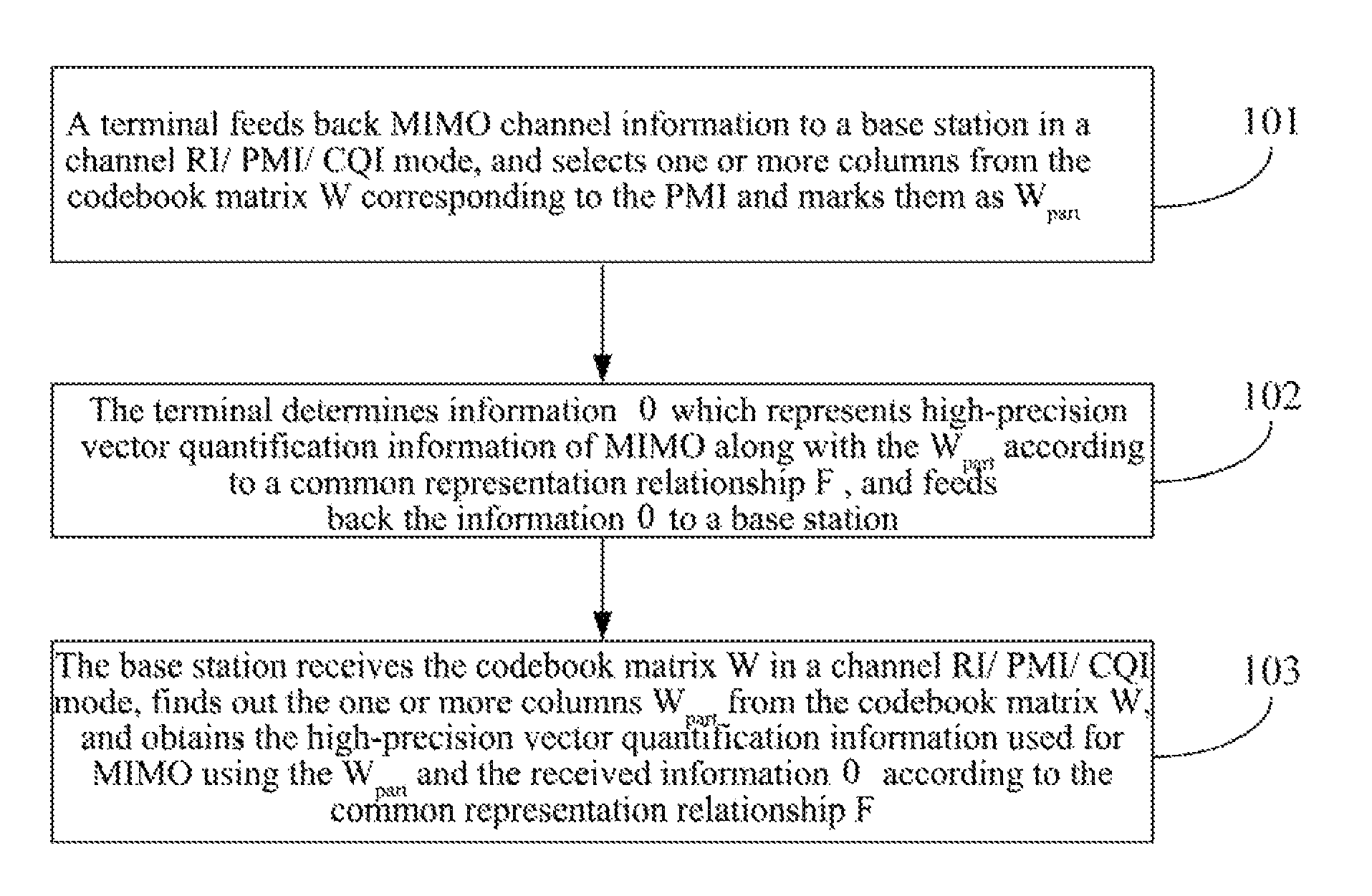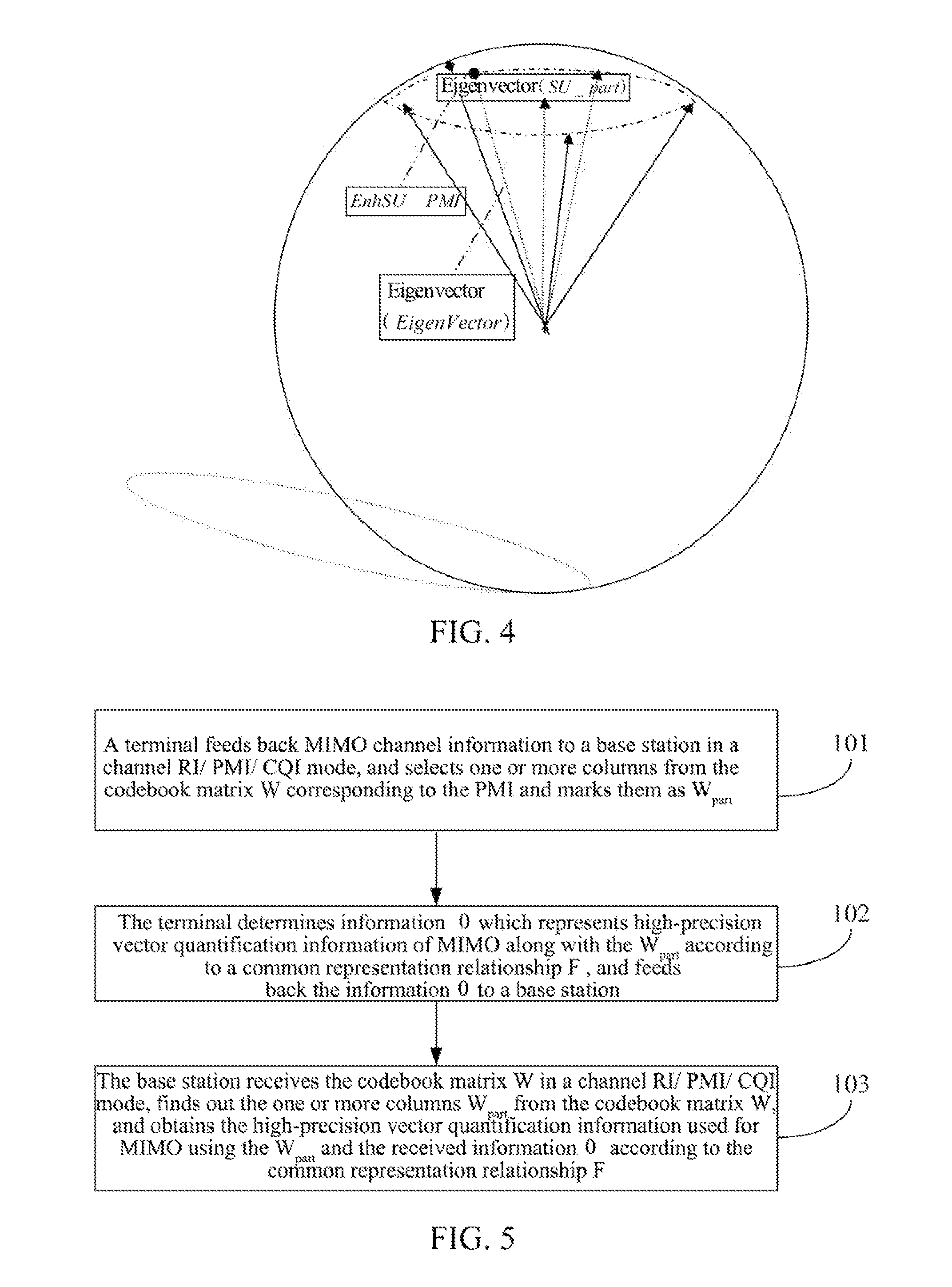Method and system for MIMO channel information feedback
a channel information and feedback technology, applied in the field of mobile broadband wireless access systems, can solve the problems of poor precoding performance of mu-mimo, base station inability to obtain accurate information, and channel information feedback technique, and achieve the effects of less overhead, less overhead, and much more complex codebooks
- Summary
- Abstract
- Description
- Claims
- Application Information
AI Technical Summary
Benefits of technology
Problems solved by technology
Method used
Image
Examples
example 1
[0086]A UE obtains channel matrix information, and selects a codeword suitable for SU-MIMO precoding from the LTE 4Tx codebook shown in Table 2 according to rules such as biggest capacity or smallest chordal distance and marks it as SU_PMI. It is assumed that the Rank is 2, i.e., the codeword is a matrix composed of two columns of vectors.
[0087]Based on one column among them, the UE considers the column as rough quantification information of a certain eigenvector. As shown in FIG. 4, the eigenvector corresponding to the column is marked as SU_part. As to which column is taken as the SU_part, the UE and the base station can make an appointment on taking a fixed certain column in the matrix as the SU_part; or, a certain column in the matrix is determined as the SU_part according to a certain appointed rule, for example, the column with the biggest CQI is taken as the SU_part.
[0088]Furthermore, by defining a mapping relationship F, a codebook (triangle arrow vector and diamond arrow ve...
example 2
[0090]Similar to Example 1, a UE obtains channel matrix information, and selects a codeword suitable for SU-MIMO precoding from the codebook shown in Table 2 according to rules such as biggest capacity or smallest chordal distance and marks it as SU_PMI. It is assumed that the Rank is 3, i.e., the codeword is a matrix composed of three columns of vectors.
[0091]Based on one column among them, the UE considers the column as rough quantification information of a certain eigenvector, and marks it as SU_part.
[0092]Furthermore, a function relationship F is defined, and a codebook indicating rotating the SU_part vector is defined as C. A rotating codebook is generally a unitary matrix and can adjust the SU_part in different directions and at different levels. A codeword is selected from C such that the SU_part is closer to the practical eigenvector after rotation of the codeword. And its index is feedback and is marked as O.
[0093]The base station, after receiving SU_PMI, finds out the spec...
example 3
[0094]In the above examples, the precision enhancement is implemented for one column of eigenvectors, and can also be implemented for two columns of eigenvectors.
[0095]Similar to Example 1, a UE obtains channel matrix information, and selects a codeword suitable for SU-MIMO precoding from the codebook shown in Table 2 according to rules such as biggest capacity or smallest chordal distance and marks it as SU_PMI. It is assumed that the Rank is 8, i.e., the codeword is a matrix composed of eight columns of vectors.
[0096]Based on two columns among them, the UE considers the column as rough quantification information of certain two eigenvectors, and marks it as SU_part, which is here a matrix indicating information of two vectors, and may also be interpreted as a two-dimensional sub-space.
[0097]Furthermore, a function relationship F is defined, and a codebook indicating rotating the SU_part vector is defined. A rotating codebook is generally a unitary matrix and can adjust the SU_part ...
PUM
 Login to View More
Login to View More Abstract
Description
Claims
Application Information
 Login to View More
Login to View More - R&D
- Intellectual Property
- Life Sciences
- Materials
- Tech Scout
- Unparalleled Data Quality
- Higher Quality Content
- 60% Fewer Hallucinations
Browse by: Latest US Patents, China's latest patents, Technical Efficacy Thesaurus, Application Domain, Technology Topic, Popular Technical Reports.
© 2025 PatSnap. All rights reserved.Legal|Privacy policy|Modern Slavery Act Transparency Statement|Sitemap|About US| Contact US: help@patsnap.com



